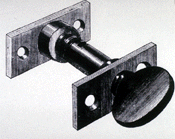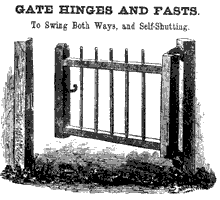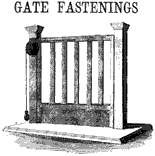The
Guidelines pertain to historic buildings of all sizes, materials, occupancy,
and construction types; and apply to interior and exterior work as well
as new exterior additions. Those approaches, treatments, and techniques
that are consistent with the Secretary of the Interior's "Standards for
Rehabilitation" are listed in bold-face type under the "
Recommended"
section in each topic area; those approaches, treatments, and techniques
which could adversely affect a building's historic character are listed
in the "Not Recommended" section in
each topic area. To provide clear and consistent guidance for owners,
developers, and Federal agency managers to follow, the "Recommended" courses
of action in each section are listed in order of historic preservation
concerns so that a rehabilitation project may be successfully planned
and completed--one that, first, assures the preservation of a building's
important or "character-defining" architectural materials and features
and, second, makes possible an efficient contemporary use. Rehabilitation
guidance in each section begins with protection and maintenance, that
work which should be maximized in every project to enhance overall preservation
goals. Next, where some deterioration is present, repair of the building's
historic materials and features is recommended. Finally, when deterioration
is so extensive that repair is not possible, the most problematic area
of work is considered: replacement of historic materials and features
with new materials.
To
further guide the owner and developer in planning a successful rehabilitation
project, those complex design issues dealing with new use requirements
such as alterations and additions are highlighted at the end of each section
to underscore the need for particular sensitivity in these areas.
How to Use The Guidelines
 Identify,
Retain, and Preserve
Identify,
Retain, and Preserve
The guidance that is basic to the treatment
of all historic buildings--identifying, retaining, and preserving
the form and detailing of thos architectural materials and features that
are important in defining the historic character--is always listed
first in the "Recommended" area. The parallel "Not Recommended" area lists
the types of actions that are most apt to cause the diminution or even
loss of the buildings's historic character. It should be remembered, however,
that such loss of character is just as often caused by the cumulative
effect of a series of actions that would seem to be minor interventions.
Thus, the guidance in all of the "Not Recommended" areas must be
viewed in that larger context, e.g., for the total impact on a historic
building.
___________________________
Protect
and Maintain
After identifying those materials and features
that are important and must be retained in the process of rehabilitation
work, then protecting and maintaining them are addressed. Protection
generally involves the least degree of intervention and is preparatory
to other work. For example, protection includes the maintenance of historic
material through treatments such as rust removal, caulking, limited paint
removal, and re-application of protective coating; the cyclical cleaning
of roof gutter systems; or installation of fencing, protective plywood,
alarm systems and other temporary protective measures. Although a historic
building will usually require more extensive work, an overall evaluation
of its physical condition should always begin at this level.
___________________________
Repair
Next, when the physical condition of character-defining
materials and features warrants additional work repairing is recommended.
Guidance for the repair of historic materials such as masonry, wood, and
architectural metals again begins with the least degree of intervention
possible such as patching, piecing-in, splicing, consolidating, or otherwise
reinforcing or upgrading them according to recognized preservation methods.
Repairing also includes the limited replacement in kind--or with compatible
substitute material--of extensively deteriorated or missing parts of features
when there are surviving prototypes (for example, brackets, dentils, steps,
plaster, or portions of slate or tile roofing). Although using the same
kind of material is always the preferred option, substitute material is
acceptable if the form and design as well as the substitute material itself
convey the visual appearance of the remaining parts of the feature and
finish.
___________________________
Replace

Following repair in the hierarchy, guidance
is provided for replacing an entire character-defining feature
with new material because the level of deterioration or damage of materials
precludes repair (for example, an exterior cornice; an interior staircase;
or a complete porch or storefront). If the essential form and detailing
are still evident so that the physical evidence can be used to re-establish
the feature as an integral part of the rehabilitation project, then its
replacement is appropriate. Like the guidance for repair, the preferred
option is always replacement of the entire feature in kind, that is, with
the same material. Because this approach may not always be technically
or economically feasible, provisions are made to consider the use of a
compatible substitute material.
It
should be noted that, while the National Park Service guidelines recommend
the replacement of an entire character-defining feature under certain
well-defined circumstances, they never recommend removal and replacement
with new material of a feature that--although damaged or deteriorated--could
reasonably be repaired and thus preserved.
___________________________
Design
for Missing Historic Features
When an entire interior or exterior feature
is missing (for example, an entrance, or cast iron facade; or a principal
staircase), it no longer plays a role in physically defining the historic
character of the building unless it can be accurately recovered in form
and detailing through the process of carefully documenting the historical
appearance. Where an important architectural feature is missing, its recovery
is always recommended in the guidelines as the  first
or preferred, course of action. Thus, if adequate historical, pictorial,
and physical documentation exists so that the feature may be accurately
reproduced, and if it is desirable to re-establish the feature as part
of the building's historical appearance, then designing and constructing
a new feature based on such information is appropriate. However, a second
acceptable option for the replacement feature is a new design that is
compatible with the remaining character-defining features of the historic
building. The new design should always take into account the size, scale,
and material of the historic building itself and, most importantly, should
be clearly differentiated so that a false historical appearance is not
created.
first
or preferred, course of action. Thus, if adequate historical, pictorial,
and physical documentation exists so that the feature may be accurately
reproduced, and if it is desirable to re-establish the feature as part
of the building's historical appearance, then designing and constructing
a new feature based on such information is appropriate. However, a second
acceptable option for the replacement feature is a new design that is
compatible with the remaining character-defining features of the historic
building. The new design should always take into account the size, scale,
and material of the historic building itself and, most importantly, should
be clearly differentiated so that a false historical appearance is not
created.
___________________________
Alterations/Additions
to Historic Buildings
Some exterior and interior alterations
to historic building are generally needed to assure its continued use,
but it is most important that such alterations do not radically change,
obscure, or destroy character-defining spaces, materials, features, or
finishes. Alterations may include providing additional parking space on
an existing historic building site; cutting new entrances or windows on
secondary elevations; inserting an additional floor; installing an entirely
new mechanical system; or creating an atrium or light well. Alteration
may also include the selective removal of buildings or other features
of the environment or building site that are intrusive and therefore detract
from the overall historic character.
The
construction of an exterior addition to a historic building may seem to
be essential for the new use, but it is emphasized in the guidelines that
such new additions should be avoided, if possible, and considered only
after it is determined that those needs cannot be met by altering secondary,
i.e., non character-defining interior spaces. If, after a thorough evaluation
of interior solutions, an exterior addition is still judged to be the
only viable alterative, it should be designed and constructed to be clearly
differentiated from the historic building and so that the character-defining
features are not radically changed, obscured, damaged, or destroyed.
Additions
to historic buildings are referenced within specific sections of the guidelines
such as Site, Roof, Structural Systems, etc., but are also considered
in more detail in a separate section, New Additions to Historic Buildings.
___________________________
Energy
Efficiency/Accessibility Considerations/Health and Safety Considerations
These sections of the rehabilitation guidance
address work done to meet accessibility requirements and health and safety
code requirements; or retrofitting measures to conserve energy. Although
this work is quite often an important aspect of rehabilitation projects,
it is usually not a part of the overall process of protecting or repairing
character-defining features; rather, such work is assessed for its potential
negative impact on the building's historic character. For this reason,
particular care must be taken not to radically change, obscure, damage,
or destroy character-defining materials or features in the process of
rehabilitation work to meet code and energy requirements.
.gif)
.gif)